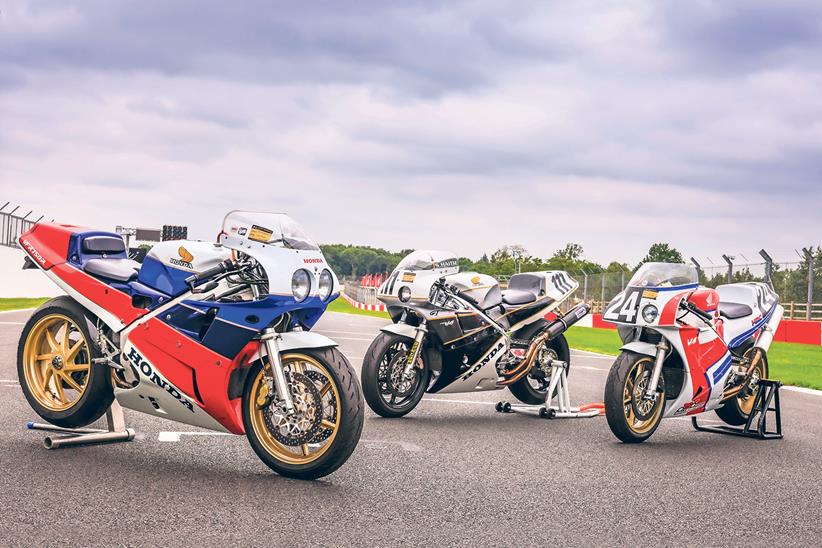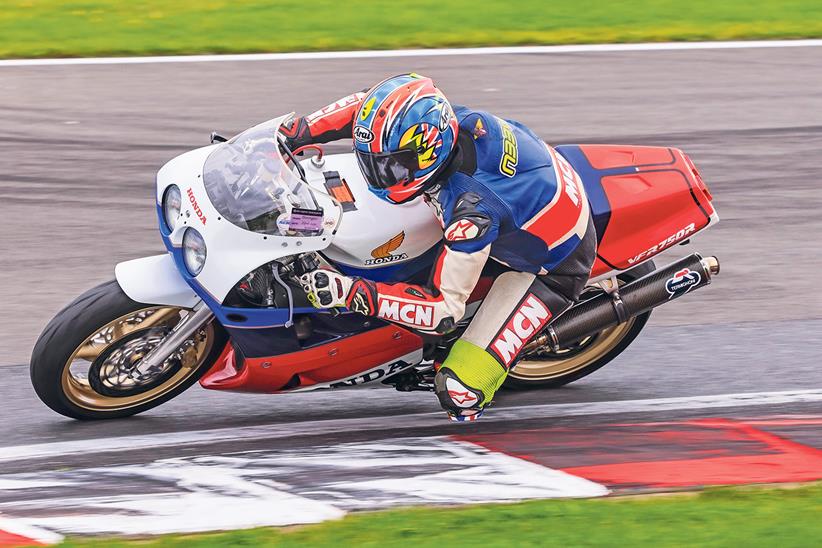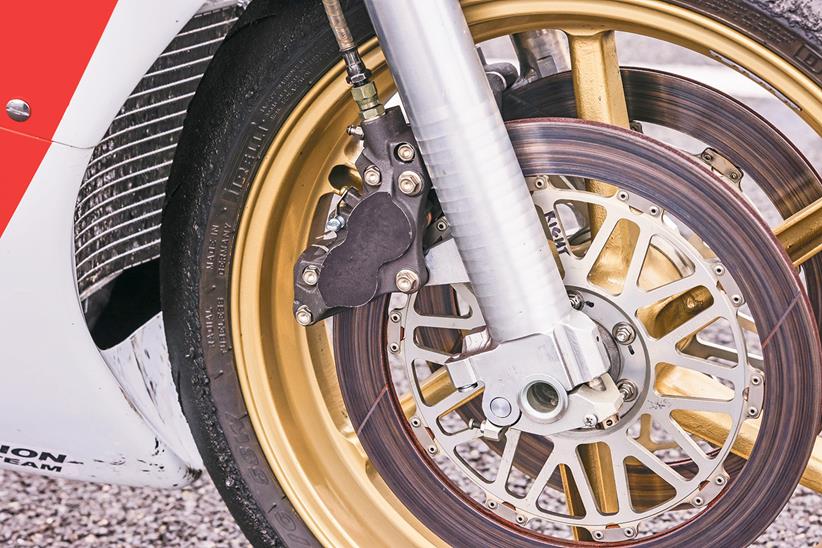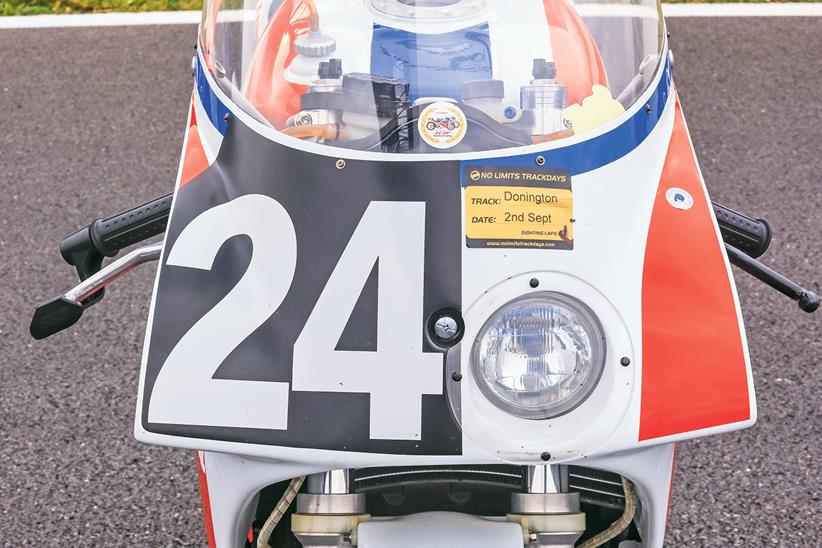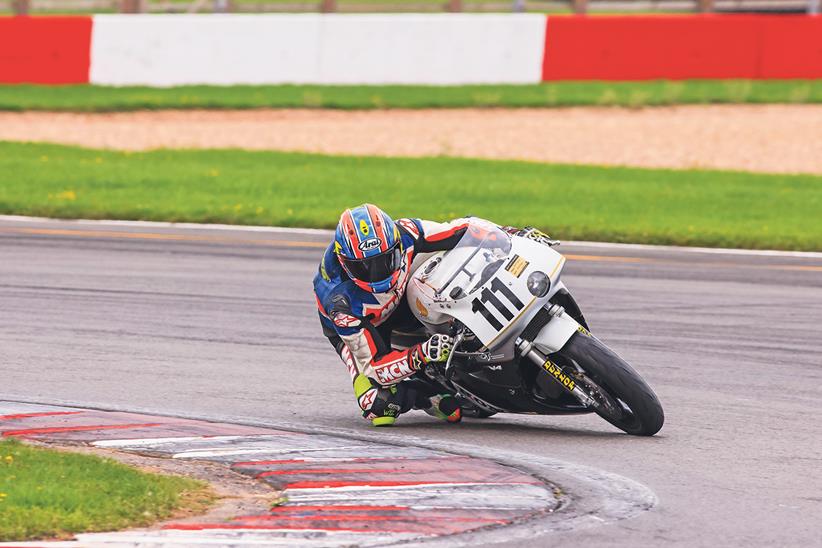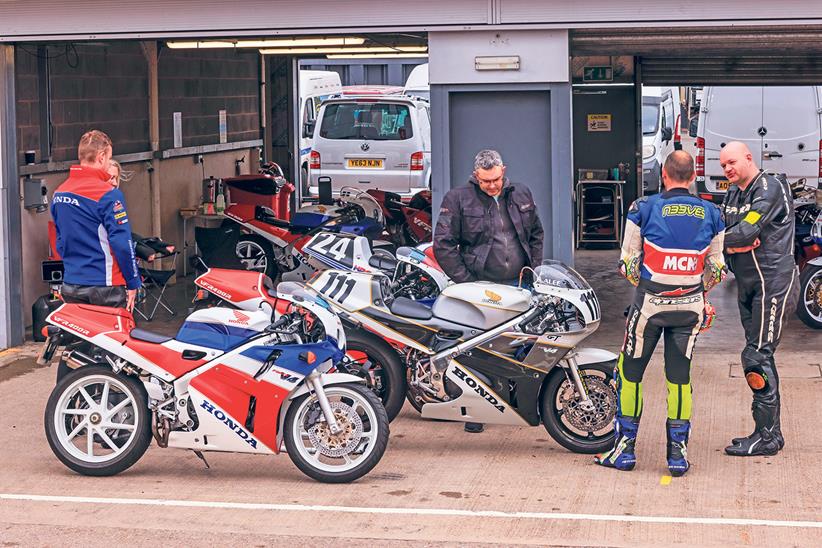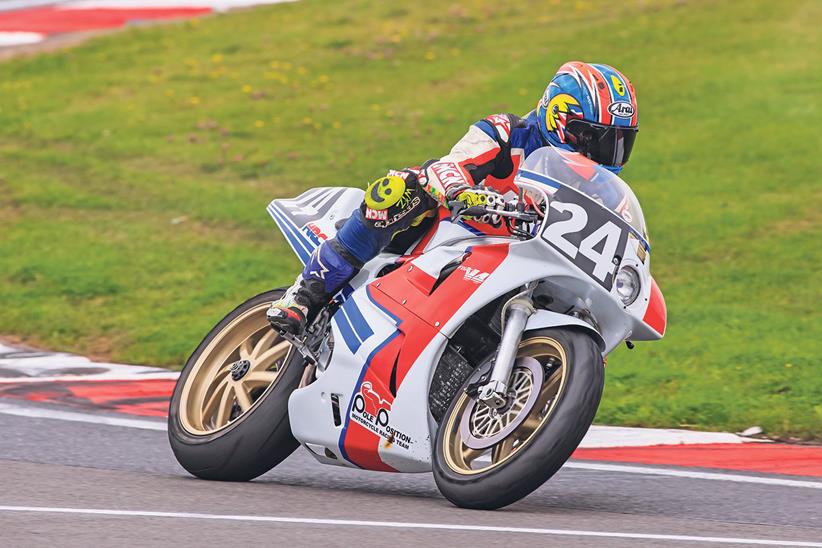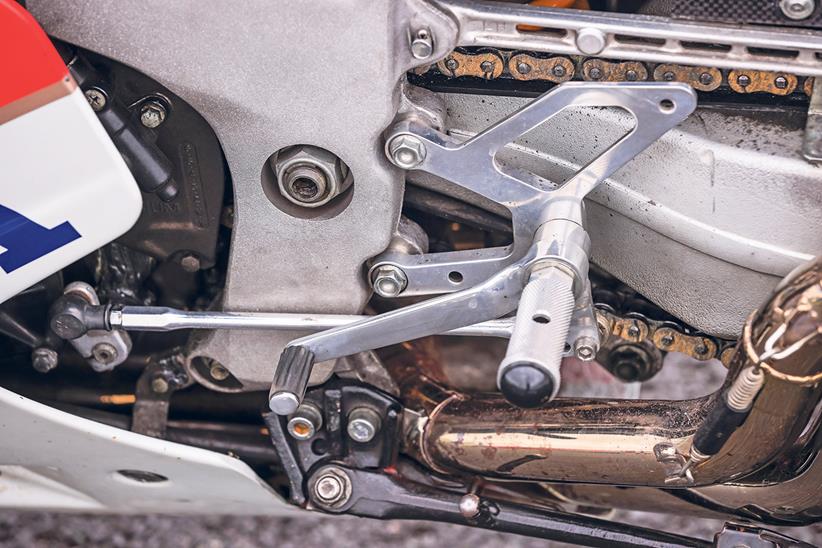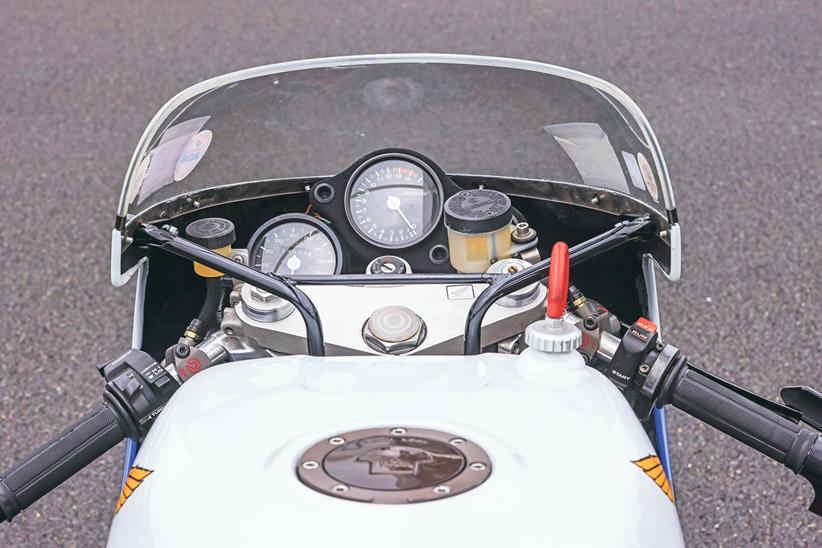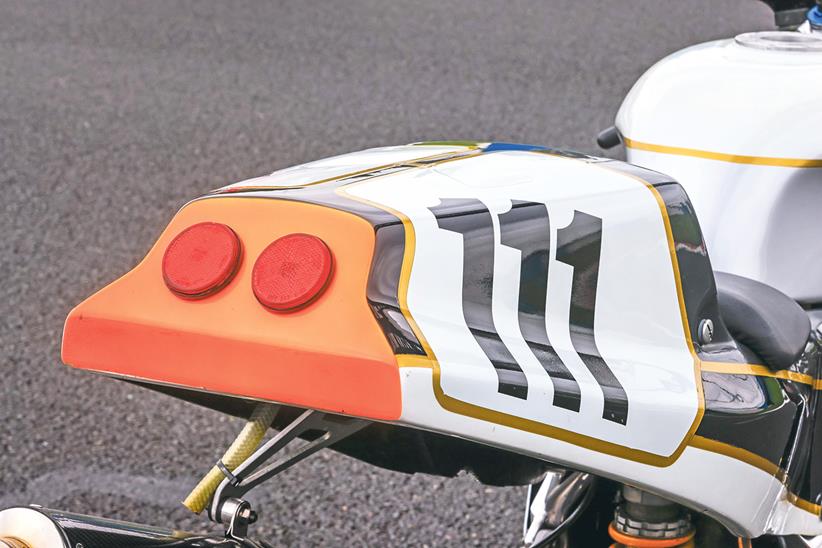Riding a trio of special Honda RC30s and meeting the men who still use them as Honda intended
For many of us, Honda’s RC30 has been an object of desire since it was released back in 1988. With around 3500 made, they’re not as rare as you might imagine, but they were expensive – twice the price of the Suzuki GSX-R750J Slingshot of the day.
The RC30 had more than of a whiff of factory race bike about it, too and was pictured next to the RVF750 endurance racer in the brochures – a bike that evokes golden memories of Gardner and Doohan at the Suzuka 8 Hours, and Foggy and Hizzy at the TT.
You’ll have read all about the road bike over the years, but racing RC30s have an almost mystical air to them.
Related articles on MCN
- Thirty years of the Honda NR750
- How close is Honda’s latest Fireblade to a BSB race bike
- Dream Ducatis: Trio of Superleggeras ridden
- How Honda took on Ducati at their own game with the SP-1
Why did their star shine so brightly in their late 80s and early 90s heyday? To help us find out after all these years the RC30 Owners Club and GT Motorcycles have brought two very special race RC30s along to Donington Park for us to taste. But before we do, a few laps to reacquaint ourselves with the road bike is in order.
The road bike
115bhp, 185kg
![]()
Ravaged by the mists of time, most 34-year-old road bikes would feel tired and dated, but not this one. Not only has owner Tom Sewell tastefully tweaked his RC30 to bring it up to date, it’s no lounge lizard, either.
In the 28 years he’s owned it, Tom’s used it exactly as Honda intended: scratching around racetracks, racking up big European road miles and clocking laps around the Nürburgring.
He’s swapped the standard 18in rear wheel for a 17-incher (with the necessary ride height adjuster to keep the geometry in check) and fitted Metzeler Racetec RR K3 trackday rubber.
Front discs are HRC kit copies (up by 10mm to 320mm) with Brembo calipers and master cylinder, the shock and fork springs are Öhlins and the engine is stock, bar a fruity-sounding Termignoni race exhaust.
A sea of perfectly proportioned eye candy, the RC30 is still as evocative in the flesh as it was back in the day.
Switchgear and analogue dials are minimalist perfection, then there’s the iconic extruded ali frame, Dzus fairing fasteners, single-sided swingarm, and bodywork that inspired a generation of sportsbikes. It’s so well built and finished that it still looks box fresh.
![]()
Compared to more spacious, modern sportsbikes the RC30 is tiny. I can’t get my big feet on the pegs properly, especially changing direction down through Craner, and in order to fully tuck in behind the screen I need to sit back on the seat hump.
It sits 1980s-low at the back, so steering is surprisingly slow, and with just 115bhp and frantic gearchanges needed to keep it on the boil, it feels more like the 399cc pocket rocket NC30 than a full-on superbike.
It barely accelerates with the urgency of a Street Triple, which is slightly unnerving when you’re on someone else’s rare pride and joy in a fast group trackday full of angry-arse modern-day superbikes (I’m glad there are no mirrors).
But as the laps tick by you soon realise you’re in the presence of greatness. The Honda is tiny, perfectly formed engine internals busily buzz beneath you, the crunchy V4 roar of the exhaust caresses your ears, and the chassis delivers majestic momentum through Donington’s curves.
Suspension is soft and brakes still weak by today’s standards (and the rear almost not existent), but it has such an insatiable hunger for corner speed and is so stable at full lean, it’s no surprise it ran rings around its rivals.
It’s a relief to give it back in one piece. RC30s are worth upwards of £20,000-£30,000 and parts don’t grow on trees.
Honda have started a refresh programme, but components aren’t cheap, as Tom explains: “A water pump is a cool £3500 and full replacement bodywork costs £20,000. Any hope of going classic racing with an RC30 is negated by the price of parts. A crank was £900 in 1988, and now it’s the price of an S1000RR“.
The endurance racer
120bhp, 155kg
![]()
This is the kind of spec a national-level RC30 racer would’ve been in back in the day, but it too has a modern twist.
Starting life as a road bike, it’s been meticulously built for modern-classic endurance racing by Stephen Alee of GT Performance Engineering.
It finished sixth at the 2018 Bol d’Or in the hands of TT winner James Hillier and its owner, GT Motorcycles boss Steve Haith, and breezed through a No Limits Endurance season, including a 10-hour at Anglesey with no issues, despite being the only single-bike team on the grid.
The engine uses kit cams, airbox, ECU and loom, with many of GT Motorcycles’ own internals. Haith says: “Part of the desire to race the RC30 was to show people that the kit we’re making at GT Performance Engineering, from cranks, rods and valves, all work.”
A single-sided swingarm and quick-release endurance forks allow wheels to be changed in 20 seconds. At Snetterton the team made up 10 laps when they pitted for wets as the heavens opened… and came back in again shortly after for slicks when the sun reappeared.
![]()
It might be worth more than the road bike (around £35-£40k), but this RC30 encourages you to push, regardless, simply because it’s a working race bike with modern tyres, suspension and brakes, built to perform in the here and now.
Haith says: “You can lean it to angles it was never designed to lean, thanks to those tyres, and you’re scraping things that were never designed to be scraped. We wore through the back brake lever at Brands.”
It’s still friendly, like the road RC30, but the V4 barks that bit louder, the midrange is stronger and harder hitting at the top.
It’s far more comfortable riding among modern trackday bikes and can even overtake a few. With its extra power it can run taller gearing, which means using the infamous tall first through the Melbourne Loop and Goddards.
With such a deliciously set-up chassis and a bit more room to move around, it’s nimbler, more stable and faster through corners. The quicker you go the more it hunkers down and grips. It isn’t a relief to give this one back – I want more.
The factory racer
140bhp, 145kg
![]()
RC30 race bikes weren’t always as they seemed. With a history that twists and turns like Suzuka’s tarmac, the factory HRC RVF750 racers that inspired the RC30 were at the top of the tree, although the first of that rarefied breed started life in ’86/’87 running modified VF750 engines.
There were also Honda R&D bikes, codenamed the E7D, which the likes of Foggy ran in Silkolene colours and featured experimental parts like upside-down forks, side-mounted radiators and twin pipes.
HRC ‘NLO’ race kits were also available to any RC30 owner with deep enough pockets and continually developed from ’88 to ’93, but if you were one of the chosen ones you could get your hands on an even more special, factory ‘NLOB’ race kit.
Which is the bike you see here, as raced at the Suzuka 8 Hours by the Pole Position team and prepared now by Stephen Alee. Other NLOBs include those used by the Pot Noodle and Moriwaki teams at Suzuka, and Merkel’s ’99 WSB title winner. Nick Jefferies ’93 TT racer ran an NLOB V4 and electronics, and Team Bike’s endurance racers used NLOB engines from Honda France.
This 1990-spec NLOB may look like an RC30, but it’s a different animal, right down to its heavily-modded chassis and short port motor, packed with unobtanium and a top end running the opposite way to the crank (with just two cogs in its cam gear train, instead of three).
![]()
A crank would’ve cost £7000 back then and its magnesium carbs £30,000. Only seven sets were made and flown by HRC engineers in a briefcase to be used at an event and taken back to Japan again. They’re priceless now.
As you’d expect, the NLOB has all the hallmarks of the factory racer to ride. It’s plush, neutral, smooth and friendly, which is exactly what you need to go fast, whether you’re the best rider in the world, or not.
It’s the sweetest steering, gruntiest and hardest accelerating RC30 here, plus it’s roomy too. It’s also a rolling museum piece full of irreplaceable parts – a nugget of knowledge that stops me getting too giddy.
Factory machine: ‘You can use that 140bhp all the time’
![]()
Steve is a talented engineer with an encyclopaedic knowledge of RC30s and their racing derivatives that boggles the mind. He’s well connected, too, regularly swapping messages with Mr Kazuo Honda, Project Leader for the RC30… and Mick Doohan’s NSR500.
“The NLOB is basically a prototype go-faster RC30 in full TT F1 spec. Only a works RVF750 is better. Honda only just won the WSB title in ’88 on an RC30 and needed something better. This is what they came up with.
“It was developed alongside the RVF750, which has to be one of the greatest endurance bikes ever. The engine went into the RVF in 1988 and was developed until 1993, before the RC45 came out in ’94.
“The first year of NLOB uses standard race kit NLO parts and a standard chassis. By the time 1991 arrives it doesn’t look like an RC30 anymore with its upside-down forks, a big brace Ducati-like swingarm and carbon discs. In ’93 it’s running an NLOB chassis and looks remarkably like an RC45 with its air intakes running through the top of the tank.
“Our 1990 bike makes 40% more power and is 50kg lighter than the road bike. The torque curve is flat so it’s very easy to ride and doesn’t feel fast, but the lap times show otherwise.
“The carbs are smaller (36mm) than the race kit stuff for drivability – a good rider can extract more if it’s easy. You can use that 140bhp all the time, rather than more, some of the time.
“The chassis is shorter and it has a different swingarm to take a wider wheel and more modern tyre. It has a short-stroke shock with a linear linkage and billet ali forks and yokes for strength.
“I’ve been involved with RC30s since I was 19 and was mentored by Brian Capper. He built engines for Team Bike, who were the best privateer team of the day. Unfortunately, he passed away a few years ago and I’ve continued his work at GT Performance Engineering.
“All I do is RC30s, from road to race, all over the world. I even build engines for the guys who work at HRC for their own club racing.”
Honda RC30 vs Ducati Panigale V4R video:
